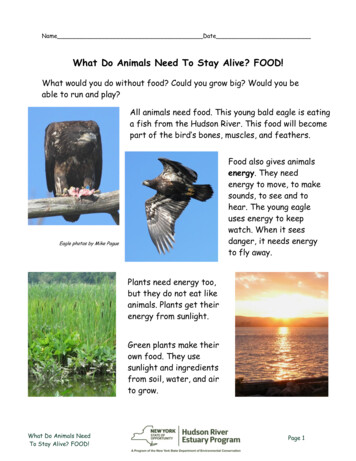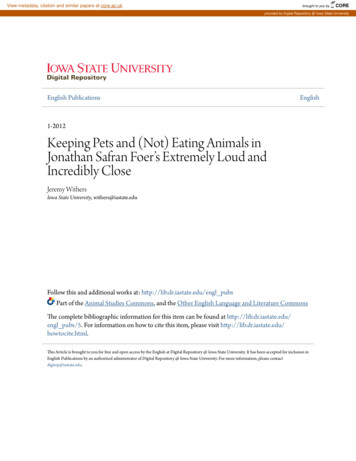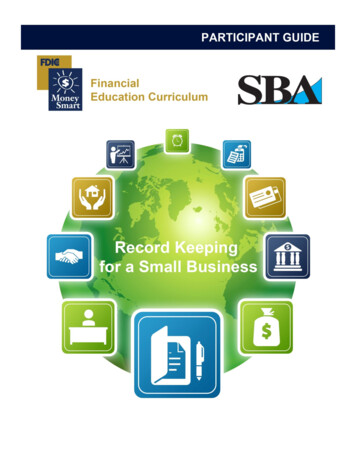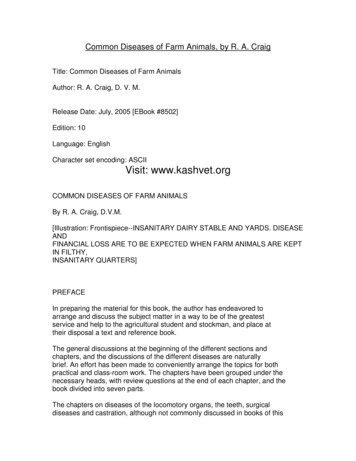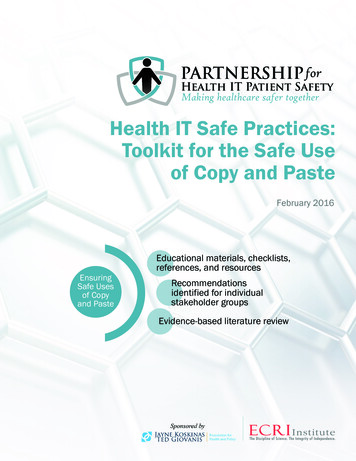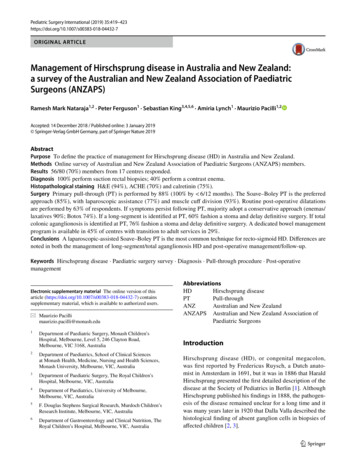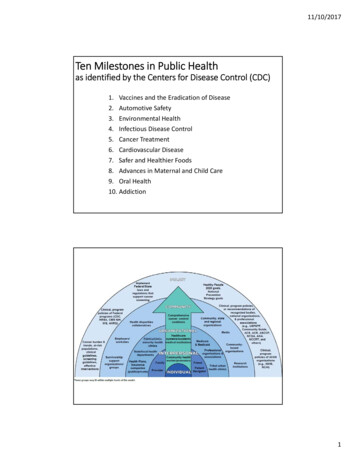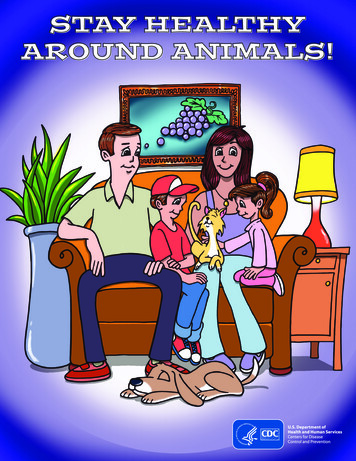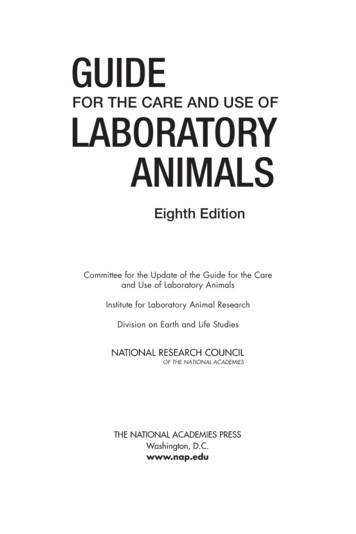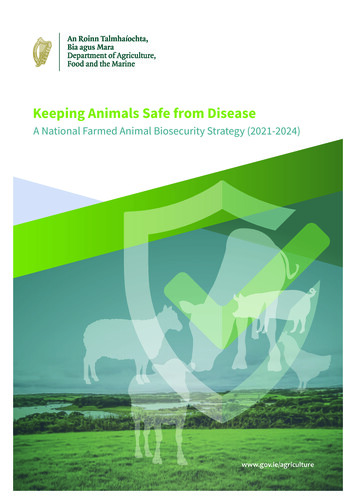
Transcription
Keeping Animals Safe from DiseaseA National Farmed Animal Biosecurity Strategy (2021-2024)www.gov.ie/agriculture
Raising the standard ofbiosecurity on all Irishlivestock farms will impactpositively on many aspects ofIrish agriculture as well asIrish society as a whole.
National Farmed Animal Biosecurity StrategyTable of Contents:
Foreword byMinister for Agriculture, Food and the Marine,Charlie McConalogue TD01
National Farmed Animal Biosecurity StrategyI am very pleased to launch my Department’sNational Farmed Animal BiosecurityStrategy. With its strategic focus onbiosecurity for the farmed animal sectors,it continues the shift in emphasis towardsdisease prevention, previously articulated inthe National Farmed Animal Health Strategy(2017-2022).Improvements in any one of these areas willresult in enhanced collective health andwelfare and in an enhanced naturalenvironment.The National Farmed Animal BiosecurityStrategy complements the Plant Health andBiosecurity Strategy (2020-2025) and giveseffect to commitments contained in theProgramme for Government to improveAnimal Health through a One Healthapproach and to support and improvebiosecurity in the intensive pig and poultrysectors.This Strategy sets out a vision for the futureof a livestock sector in which the highbiosecurity status of the holding issomething which is valued by the individualfarmer. In this vision, the farmer has theknowledge, skills and supports necessary toprotect and maintain the biosecurity statusof the holding, while at the national level,farmers and all stakeholders are collectivelyaware of the value of biosecurity to thehealth of the national herd and flock, to ourability to access international markets and tothe economic performance of theagricultural sector as a whole.This strategy was developed followingconsultation with a broad range ofstakeholders and its success will rely on allstakeholders, including my Department,working in partnership to ensure that wecollectively achieve a substantialimprovement in all aspects of farmbiosecurity.Raising the standard of biosecurity on allIrish livestock farms will impact positively onmany aspects of Irish agriculture as well asIrish society as a whole. The focus on diseaseprevention is a clear example of the holistic‘One Health One Welfare’ approach myDepartment is developing across a range ofpolicy areas. The ‘One Health One Welfare’concept explicitly links animal health andwelfare, public health and wellbeing andenvironmental health.I would like to take this opportunity to thankall stakeholders for their contributions to thisdocument, which provides a clear path forraising farm biosecurity standards in Ireland.I look forward to supporting all stakeholdersin delivering the desired impacts of thisstrategy over the coming years. I amconfident that it can provide benefits foranimal health, animal welfare, public health,the environment, the economy and societyas a whole.02
Executive SummaryThis strategy builds on many of the key principles of the National Farmed AnimalHealth Strategy [NFAHS](2017-2022), which emphasises the need to work inpartnership, to acknowledge roles and responsibilities, to reflect costs and benefits,and to shift the focus from curing to preventing animal disease. Keeping the animalsin our national herd and flock safe from disease – starting inside the farm gate - is anintegral part of the ‘One Health One Welfare’ approach and entirely consistent withthe principles set out in the NFAHS.The good health status of our farmed animals is fundamental in underpinning thecontinued success of the Irish livestock sector. The ability to raise our defences in theface of a specific threat (such as African Swine Fever) is important, but it is equallyimportant that effective, routine farm biosecurity practices are put in place and arepracticed consistently every day of the year, whether or not a specific disease threathas been identified. When good biosecurity practices are in place on farm and whenthey are implemented routinely and effectively, they reduce the risk of introducingdisease into, and of spreading it within, the farm. The level of risk reduction will bedetermined by how effectively and routinely good biosecurity measures areimplemented and practiced.This strategy outlines a vision of what an effective farmed animal biosecurity strategyin Ireland will look like.Six broad strategic actions, considered central to the successful implementation ofthis strategy, are outlined. These are grouped into 3 areas, organised around theconcept of behaviour change (see Figure 1).03
National Farmed Animal Biosecurity StrategyFigure 1:A. Awareness to drive behaviour changeStrategic Action 1Creation of an online central information hub for key biosecurityinformation.B. Knowledge & ‘Know-how’ to drive behaviour changeStrategic Action 2DAFM and all stakeholders to identify data and knowledge gaps in relationto factors constraining and promoting the adoption of good biosecuritypractices. These gaps to be addressed through research, including theDAFM funded research calls.Strategic Action 3Develop and publish Codes of Practice for farm biosecurity and use riskassessment tools to measure how effectively they are applied.C. Policy to drive behaviour changeStrategic Action 4DAFM to utilise new and existing legislative provisions to encourageadoption of appropriate biosecurity measures.Strategic Action 5Collaboration between the Competent Authorities in Ireland and NorthernIreland in relation to the biosecurity status of the island of Ireland isfurther enhanced to give full effect to its status as a single epidemiologicalunit for the purposes of animal health and welfare.Strategic Action 6DAFM will provide an appropriate governance structure to ensureimplementation of this strategy by all stakeholders.The successful implementation of the National Farmed Animal Biosecurity Strategyrequires all stakeholders to work closely together in partnership. Regular communicationon progress will be disseminated at interactive stakeholder forums and events, such as theannual Animal Health Awareness Week. The already established Review Body for theNational Farmed Animal Health Strategy will be the vehicle for the oversight andgovernance of this strategy.Stakeholder input was of critical importance in the development of this strategy, and theoutcome of the consultation strongly influenced the strategic actions. An ambitious butachievable pathway is proposed, placing biosecurity front and centre in the plan for thesuccess and sustainability of Irish livestock farming.04
Chapter 1IntroductionFarm-level biosecurity can be described as the combination of both management andphysical measures which, if practiced effectively and routinely, reduce the risk of theintroduction, development and spread of disease to, from and within a farm.Practicing good biosecurity on farm is key to protecting and improving animal health,welfare and productivity, as well as ensuring good public health, through reducedantimicrobial and antiparasitic medicine usage, reduced transmission of zoonoticdisease and improved environmental health. Ultimately, good biosecurity helpsunderpin sustainable and productive agricultural practices in Ireland.In the international context, the Food and Agriculture Organisation of the UnitedNations (FAO), the World Organisation for Animal Health (OIE) and the World HealthOrganisation (WHO), recognise that the health of humans is intrinsically connected tothat of animals and to the environment.EU and national legislation provide legislative powers to enable competentauthorities strengthen the standards of farm biosecurity in their states. In Ireland,fostering good biosecurity practices has been identified by DAFM as an essentialcomponent of a holistic approach to improving both animal and public health, givingeffect to the ‘One Health, One Welfare’ principle. Consistent with this principle, theNational Farmed Animal Biosecurity Strategy is intended to complement andreinforce a number of DAFM strategies (see Figure 2), including those for animal andplant health, animal welfare, disease eradication and surveillance as well as for foodsafety and antimicrobial resistance.Achieving the desired impacts (see Figure 3), will depend on the active engagementand support of all stakeholders.05
National Farmed Animal Biosecurity StrategyFigure 2:Key DAFM and National StrategiesCurrent: National Farmed Animal Health Strategy (NFAHS) 2017-2022 Ireland’s National Action Plan on Antimicrobial Resistance 2017-2020 (iNAP) National Animal Health Surveillance Strategy 2016-2021 Food Safety & Food Authenticity Strategy (FSFA) 2017-2020 Foodwise 2025 Plant Health & Biosecurity Strategy 2020-2025 Climate Action Plan 2019 Programme for Government ‘Our Shared Future’ 2020In development: Ireland’s Animal Welfare Strategy 2030 Agri-Food Strategy A Ten Year Roadmap to Reduce bTB and Drive Towards Eradication 2020-2030Figure 3:Desired Impacts of the National Farmed Animal Biosecurity Strategy: The prevalence of endemic disease is reduced.Ireland is better protected against exotic disease.The health and welfare of the national herd and flock improves.There is improved collection, use, dissemination and communication ofinformation on biosecurity.There is a significant reduction in the use of antimicrobials andantiparasitic medicines.Food safety improves.There is improved farm productivity and efficiency.There is a clear contribution to the reduction in agricultural greenhouse gasemissions, to improved public health and well-being, and to betterenvironmental health.Ireland’s efforts to expand access to international markets are supported.06
Chapter 2A Vision for Farmed Animal Biosecurity in IrelandThe vision is of an Irish livestock farming sector in which the highbiosecurity status of the farm is valued and where farmers are properlyequipped to address general and specific risks to this status, supported byhigh quality, real-time information and farm-specific advice provided bytheir veterinary practitioner and other relevant advisors. All stakeholdersare aware of the high value of biosecurity to the health of the nationalherd/flock, to our ability to access international markets, and to theeconomy as a whole.07
National Farmed Animal Biosecurity StrategyIn order to realise this vision, the following outcome indicators will need to be achieved:Improved Awareness Farm service providers and suppliers areaware of their role in achieving farmbiosecurity standards appropriate to the levelof disease threat and they observe thestandards set out in the relevant biosecurityplans and/or biosecurity codes of practice. DAFM provides a central hub for biosecurityinformation, containing sector specific codesof practice (including those for farm serviceproviders and suppliers) which, ifimplemented, can effectively mitigate thethreat posed by endemic or exotic diseasesand can be adapted to take account of thelevel of risk posed. All stakeholders implement the NationalFarmed Animal Biosecurity Strategy, areaware of their roles and responsibilities andwork in partnership to improve the health ofthe national herd/flock by reducing theprevalence and impacts of endemic diseasesand by acting to prevent the incursion ofexotic diseases.Improved Knowledge In consultation with their veterinarypractitioners and other relevant advisors, andwith direct access to real-time diseasesurveillance information relevant to their ownherds/flocks, farmers have a goodunderstanding of the baseline animal healthstatus of their holdings. Farmers develop, implement and regularlyreview tailored herd/flock health programmesfor their farms, with biosecurity as an integralelement. Farmers are equipped to rapidly implementenhanced biosecurity practices in response tospecific disease threats. Codes of practice are jointly produced by therelevant stakeholders, working togethercollaboratively. These include FarmOrganisations, DAFM, State Agencies,Research Organisations, Public-PrivatePartnerships and Industry.Effective Policy Implementation All Industry Partners and GovernmentAgencies have the resources, expertise andtools to support farmers to measure theirfarm specific biosecurity risks, to upskill theirbiosecurity practices and to improve theirbiosecurity standards on farm. DAFM continues to implement the All IslandHealth & Welfare Strategy with DAERA. DAFM effectively communicates to farmersduring periods of medium and high diseaserisk and farmers implement their on-farmcontingency plans accordingly.08
Chapter 3The ConsultationUnderpinned by the same set of broad principles set out in the NationalFarmed Animal Health Strategy, DAFM took the initiative in 2019 to workwith stakeholders to develop a National Farmed Animal BiosecurityStrategy. Stakeholders were engaged in a phased consultation process,the outputs of which strongly inform and guide this strategy.Internal Gap AnalysisAn internal gap analysis was conducted within DAFM in early 2019, attracting responses froma wide range of DAFM Divisions. The analysis showed that, although biosecurity advice isavailable for all livestock species, the information tends to be disease specific, with a focuson certain Part A Notifiable Diseases, such as Foot and Mouth Disease, TB, AvianInfluenza and African Swine Fever. There was limited evidence of availability of generalbiosecurity advice for farmers (see Strategic Actions 1 & 3), although in many cases, thedisease-specific guidance could be easily applied or adapted for a range of disease agents.09
National Farmed Animal Biosecurity StrategyFigure 4: Some key responses to thesurvey question: List the first threewords that come into your head whenyou hear the word "Biosecurity"External attitudinal survey-current attitudesof farming sector towards biosecurityA stakeholder survey, conducted duringthe National Ploughing Championships inSeptember 2019, was aimed at thewider agricultural sector. The objective of thesurvey was to gain an understanding ofcurrent attitudes towards, andunderstandings of, farm-level biosecurity.Key findings in the survey were: The vast majority of respondents wereaware that biosecurity included bothphysical and management measures andthat on-farm biosecurity involved bothinternal and external biosecuritymeasures. Regarding the ability to prevent, identifyand respond to biosecurity challenges,farmers gave themselves an average scoreof 90%. On average, farmers awardedboth their immediate farming neighbourand DAFM a score of 70%. In order of importance, respondents feltfarmers had the most responsibility forfarm biosecurity in Ireland, withveterinary practitioners ranked secondand DAFM ranked third. Respondents ranked the cost of makingstructural changes as the greatest barrierto implementing effective biosecuritypractices, followed by the cost of labourand then purchasing stock of unknowndisease status. Discussion groups were deemed thepreferred mode for raising awareness andfor knowledge transfer, followed by farmwalks/visits and then publications andnewsletters. Online educational materialwas preferred over hardcopy versions.10
Stakeholder ForumA wide range of stakeholders was represented at the stakeholder forum, held inlate 2019, including farmers, vets, hauliers, researchers, regulators andrepresentatives of semi-state bodies. The objectives of the forum were to firstlygain a better understanding of the status quo in relation to farm biosecurity andsecondly to broadly discuss possible measures for inclusion in the NationalFarmed Animal Biosecurity Strategy.Stakeholders’ views on Ireland’scurrent approach to biosecurity: The importance of biosecurity forpublic health (including transmissionof antimicrobial resistant organisms) isnot recognised as it should be (seeStrategic Action 1). Current approach is disease specific. Farmers could do more to reduce thenumbers of visitors to their farms. Biosecurity measures are critical formanaging both endemic and exoticdiseases. There is a perception amongst farmersthat they have a low level of controlover certain aspects of disease control,which can de-motivate.11 Veterinary practitioners are an underused resource for disease prevention.They are not just a fire-brigade service(see Strategic Action 3). There is a need for biosecuritystandards to be established (seeStrategic Action 3). Farmers are responsible for farmbiosecurity and DAFM is responsiblefor national biosecurity.
National Farmed Animal Biosecurity StrategyStakeholders’ visionfor a new approach: Awareness of the cost of a diseaseoutbreak on a farm should be a drivingfactor. Economic benefits of goodbiosecurity should be examined (seeStrategic Action 2). Education and awareness are key. Ifresources and supports are available,improving one’s biosecurity ‘knowhow’ doesn’t necessarily have to costmoney and improvements in this areawill be critical to implementing thestrategy (see Strategic Actions 1 & 3). Biosecurity risk assessments are key toidentifying farm-specific risks. Followup visits are required to ensure areasof weakness are addressed (see StrategicAction 3). Herd/flock owners should be aware oftheir own biosecurity risk and that ofthe herds/flocks they purchase from. There is no lack of biosecurity information,but correct dissemination of information iscritical. A central biosecurity information‘hub’ is required (see Strategic Action 1). At a minimum, sector specific biosecuritystandards are required(see Strategic Action 3). The meeting of agreed biosecuritystandards was suggested as a possiblecondition for herd/flock registration. Farmers were identified as key in theimplementation of the National FarmedAnimal Biosecurity Strategy. DAFM was identified as having aleadership role for the delivery of thestrategy and ensuring compliance withany biosecurity standards or legislation(see Strategic Action 4). DAFM should consider linking supports tothe farmed animal sector to their meetingagreed biosecurity standards (seeStrategic Action 4). The possibility of a ‘One Health’ label orsimilar for products originating from farmsthat meet agreed biosecurity standardsshould be explored, perhaps using Bord BiaQuality Assurance Schemes (see StrategicAction 3). Ultimately, a behaviour change is required(see Chapter 4). Information is power. Empowering farmersthrough collecting farm specific data andfeeding this back in a user-friendly way willhelp drive implementation on farm (seeStrategic Action 3). Public awareness of farm biosecurity isessential; for example, tourists, walkers andhunting organisations(see Strategic Action 1). A holistic approach to biosecurity is vitaland should go beyond just a focus on thefarm itself. It should include feed, farmservice providers, marts & exhibitions orshows (see Strategic Action 3).12
Chapter 4Realising the Vision through Behaviour ChangeBiosecurity is not a new concept. The consultation showed that the theory ofbiosecurity is well understood amongst farming stakeholders. However, putting thattheory into practice will ultimately require a marked behaviour change and a definiteshift towards a culture of ‘prevention is better than cure’. Effective biosecurity must beconsidered and practiced at all times and not just in the face of disease outbreaks.The word ‘practice’ is key here -biosecurity is not only about physical measures. It isalso about day to day behaviour and herd/flock health management, both for theprevention of diseases not present and for the containment of diseases that arealready present. All stakeholders must adopt a meaningful biosecurity culture andensure that biosecurity is considered and practiced when carrying out all farmingrelated tasks no matter how routine.Six strategic actions are outlined in this chapter and are central to the successfulimplementation of this strategy. The strategic actions are grouped into 3 areas:A. Awareness to drive behaviour changeB. Knowledge and ‘Know-how’ to drive behaviour changeC. Policy to drive behaviour change13
National Farmed Animal Biosecurity StrategyAwareness to drive behaviour changeThe consultation highlighted the need for a single and central point of biosecurityinformation. There is no lack of biosecurity information available to stakeholders, but itwas felt that there is often duplication of information from multiple sources. Correctdissemination of agreed sector-specific biosecurity standards and supporting toolkitswas proposed.Strategic Action 1Creation of an online central informationhub for key biosecurity information.Action requiredCollate existing information, previously developed by DAFM or byorganisations such as Teagasc and Animal Health Ireland, andgenerate new content to develop an online centralised hub forbiosecurity information to include: Sector specific Codes of Practice. A toolkit to assist all stakeholders in incorporating the Code ofPractice into their biosecurity plan. Links to relevant organisations and schemes.An awareness campaign on the importance of farm biosecurityfor animal health and productivity, animal welfare, public healthand the environment, aimed at both farming stakeholders andthe general public, will coincide with the launch of the‘biosecurity hub’ on the DAFM website.ResponsibilityDAFM and all stakeholders.Key Performance IndicatorLinks to relevant biosecurity information are available in thecentral information hub on the DAFM website.14
Knowledge & ‘Know-how’ to drivebehaviour changeEstablishing baseline standards of biosecurity for each sector will inform all farming stakeholders,such as farmers, farm service providers, hauliers, mart owners and agricultural show organisers ofthe minimum biosecurity requirements that must be put in place to protect animals from disease.Measuring the effectiveness of biosecurity measures by carrying out regular biosecurity riskassessments will assist farmers in identifying and prioritising areas for improvement and providethem with a set of measures for addressing any deficiencies.The establishment and implementation of tailored herd/flock health programmes withbiosecurity as a core component can play a key role in safeguarding animal health. Knowing thefinancial cost of poor biosecurity and any other barriers to behaviour change is also required.The following strategic actions will help drive improvements in knowledge and ‘know-how’:Strategic Action 2DAFM and stakeholders to identify data and knowledgegaps in relation to factors constraining and promotingthe adoption of good biosecurity practices. These gapsto be addressed through research, including the DAFMfunded research calls.Action requiredDAFM and stakeholders, working in partnership, to form aworking group to identify data and knowledge gaps in relationto the factors constraining and promoting the adoption of goodbiosecurity practices.DAFM to take account of the identified knowledge gaps inshaping future funded research calls.15ResponsibilityDAFM and all stakeholders.Key Performance IndicatorNumber of research projects on factors affecting the adoptiongood biosecurity practices.
National Farmed Animal Biosecurity StrategyStrategic Action 3Action requiredDevelop and publish Codes of Practice for farm biosecurity and userisk assessment tools to measure how effectively they are applied.All stakeholders, including farm service providers, will work together todevelop sector specific codes of practice appropriate to the degree of risk.Toolkits will also be developed to assist stakeholders with incorporating thecode of practice into their biosecurity plans and daily tasks.The Minister will establish or adopt sector specific codes of practice forbiosecurity measures. Intensive sectors will be prioritised.For farmers, the code of practice will include a requirement for thedevelopment, implementation and regular review of farm specific biosecurityplans in close collaboration with their attending veterinary practitioner. Theeffectiveness of farm biosecurity plans will be measured, using standardisedand validated biosecurity risk assessments.For farm service providers, the code of practice will include a requirement forthe development and implementation of specific procedures by enterprise type.For mart and agricultural show owners/organisers, the code of practice willinclude a requirement for the development and implementation of sitespecific biosecurity plans that are tailored for the relevant species.For all sectors, biosecurity plans will contain contingency arrangements forperiods of both medium and high disease risk.The relevant stakeholders, including farm service providers, will hold trainingevents or develop formal accredited courses to improve biosecurityknowledge within their sectors.DAFM and Animal Health Ireland will build on pilot TASAH biosecurityprogrammes for pigs and poultry and introduce for other species.Compliance with biosecurity codes of practice will become a requirement forBord Bia Assurance Schemes. Marketing opportunities will be explored.ResponsibilityDAFM and all stakeholders.Key Performance IndicatorThe number of Codes of Practice published on the DAFM website.The percentage of relevant holdings and enterprises that have a biosecurityplan in place.The percentage of relevant holdings and enterprises that have reviewed theirbiosecurity plan in the relevant review period.The number of TASAH supported biosecurity reviews completed.The qualitative outcomes of the TASAH biosecurity reviews, which provide anindication both of individual farm-level progress and of change at the nationallevel.Number of biosecurity training events or courses organised by stakeholders.16
Policy to drive behaviour changeGiving legal effect to available biosecurity related provisions in new and existing legislationwill help drive behaviour change. The Minister has the power to establish or adoptbiosecurity Codes of Practice or can reduce or refuse payments to farmers who fail to takeappropriate biosecurity measures. DAFM can also avail of mechanisms within the currentCAP and within the new CAP Strategic Plan (CSP) Regulations to ensure that relevantsupports are made available to the farming sectors.Strategic Action 4DAFM to utilise new and existing legislative provisions toencourage adoption of appropriate biosecurity measures.Action requiredDAFM to fully utilise the available biosecurity related provisionsof both national (e.g. Animal Health and Welfare Act) andEuropean (e.g. Animal Health Law and CSP Regulation)legislation.DAFM supports following disease incidents are contingent on theextent to which farmers have implemented their relevant code ofpractice.ResponsibilityDAFMKey Performance IndicatorNumber and percentage of holdings availing of biosecurityrelated supports under the current RDP and future CAP.17
National Farmed Animal Biosecurity StrategyStrategic Action 5Collaboration between the Competent Authorities inIreland and Northern Ireland in relation to thebiosecurity status of the island of Ireland is furtherenhanced to give full effect to its status as a singleepidemiological unit for the purposes of animal healthand welfare.Action requiredDAFM to strengthen the existing strong collaborative relationshipwith DAERA and ensure alignment of biosecurity strategies.ResponsibilityDAFMKey Performance IndicatorNumber of DAFM/DAERA meetings on alignment of biosecuritystrategies.Strategic Action 6DAFM will provide an appropriate governance structureto ensure implementation of this strategy by allstakeholders.Action requiredThe National Farmed Animal Health Strategy Review Body willprovide oversight of this strategy.DAFM will facilitate stakeholder collaboration by providingsecretariat.ResponsibilityDAFMKey Performance IndicatorNumber of governance review meetings convened by DAFM.Number of stakeholder engagement sessions facilitated byDAFM.18
Chapter 5Working in Partnershipto Implement the StrategySuccessful ImplementationIn order to ensure the successful implementation of the National Farmed AnimalBiosecurity Strategy, it is critical that all stakeholders work together and takeresponsibility for their respective actions. Although there is shared ownership of thisstrategy, Chapter 4 clearly defines the roles and responsibilities for each of the 6strategic actions. Annual progress reports will be published and developments will bediscussed at annual interactive stakeholder forums, which will help identifychallenges and obstacles and facilitate discussion on their resolution. Presentationswill be delivered to the general farming community at relevant events, such as theannual Animal Health Awareness Week.GovernanceThe National Farmed Animal Biosecurity Strategy will be subject to objectiveoversight and governance by the already established NFAHS Review Body.19
National Farmed Animal Biosecurity StrategyNotes20
Farm-level biosecurity can be described as the combination of both management and physical measures which, if practiced effectively and routinely, reduce the risk of the introduction, development and spread of disease to, from and within a farm. Practicing good biosecurity on farm is key to
